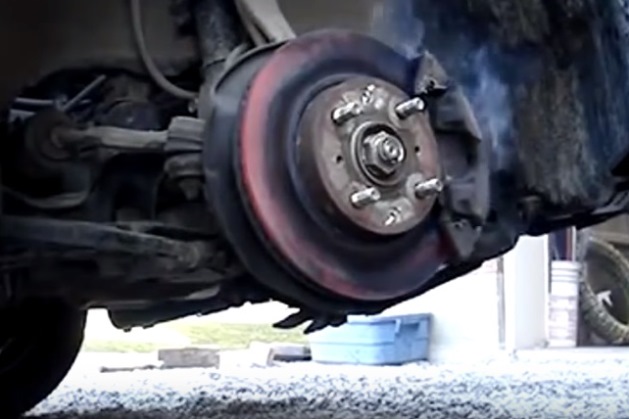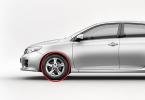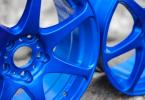The braking system is one of the key in the car. Its malfunction or incorrect operation leads to the impossibility of operating the machine. Vehicles with broken brakes are prohibited by law from driving on roads - this is extremely dangerous. Regardless of how exactly the malfunction manifests itself on your particular car: does the steering wheel vibrate, does the car pull aside when braking, or brake fluid oozes from the hose. We've rounded up 10 surefire signs of brake problems that need urgent repair.
How the brakes work
To understand what can happen to the braking system, let's first figure out how it works. In all modern cars, this assembly includes brake discs or drums and pads that mechanically slow the vehicle down. When the brake pedal is pressed, the driver mechanically moves the piston in the master brake cylinder, then the brake fluid, moving along the lines, activates the wheel brake cylinders. Those, in turn, presses the pads with a special friction compound to the discs or drums - the car starts to slow down. The system also includes a vacuum brake booster to minimize pedal pressure and a brake fluid expansion tank. Many vehicles are equipped with an electronic system that prevents the wheels from locking during braking, known as ABS.
10 most common problems
1. Wear of brake pads

Brake pads are the most unreliable element of the brake system, requiring regular replacement. In a disc brake system, the pads work without problems on average up to 40 thousand km, after which they are replaced with new ones with a set. This is due to the design of the part. The pad is a metal plate with an abrasive pad. The latter wears off over time from contact with the cast iron disc, turning into dust. Often, it also collapses from overheating or simply peels off from the base. A characteristic symptom of a malfunction is a decrease in the level of brake fluid in the expansion tank or a creak and grinding noise during braking. This clearly hints that the pads need to be replaced.
2. Wear of brake discs and drums

Exactly the same applies to brake discs and drums. These parts live on average twice as long as the pads. That is, a brake disc or drum can withstand two sets of pads, after which it must be replaced with a new one. The wear limit of these parts is indicated by the manufacturer in the documentation and should not be exceeded by the consumer. For this reason, the popular service of grooving brake discs can be attributed to the category of relatively honest taking money from motorists - as a rule, it is a disservice. Other signs of the need to replace discs are vibration on the steering wheel during braking and a faded color of the part, indicating severe overheating. The latter leads to warping and deterioration of deceleration, or even to the impossibility of correct operation of the ABS.
3. Leaks in the hydraulic line
One of the most dangerous brake breakdowns is the depressurization of the brake line. It manifests itself quite simply: when you press the pedal, the latter goes to the floor with almost no resistance, while the car does not decelerate significantly. If this happens to your vehicle, stop immediately using engine braking or mechanical parking brake, and with utmost caution. Locate the leak and replace the damaged tube or hose, then bleed the system. It is deadly to drive a car with such a malfunction!
4. Wear and seizure of the caliper guides, misalignment of the brake cylinder
The pistons of the working brake cylinders and the caliper guides oxidize over time and can begin to wedge. This leads to deterioration in braking and its unevenness. This is manifested by moving the car to the side when you press the brake pedal. Often, wedging leads to overheating of the discs and drums, as well as to increased wear of the brake pads. This issue has a significant impact on security and needs to be addressed as soon as possible. Driving is especially dangerous in winter and in rainy weather - it can cause your car to turn suddenly.

5. Deformation of brake discs
Brake discs are usually cast iron. And this material, as you know, does not like sudden changes in temperature. Be careful not to let them overheat, especially when driving on mountain serpentines or towing a heavy trailer. It is not recommended to force fords with very hot discs - this can lead to their curvature and the need for premature replacement. We have already mentioned the symptoms of the problem - these are vibrations on the steering wheel when decelerating, an increase in braking distance and premature operation of the ABS system.
6. Weak deceleration

Poor deceleration is usually due to heavy wear on brake pads, discs and drums, but there are other reasons as well. This may be due to overheating and boiling of the brake fluid. In this case, performance is restored as soon as the mechanisms acquire a normal temperature. Also, deterioration in braking can occur due to depressurization of the vacuum brake booster or wedging of the master brake cylinder. These parts must be replaced with new ones.
7. Smoke and burning smell from brakes

Smoke or strong smell emanating from the brakes is a sure sign of overheating and imminent brake system failure. Overheating leads to the formation of dross on the surfaces, which interferes with the normal operation of the mechanisms. Also, an unpleasant smell and smoke can occur due to the ingress of technical fluids and lubricants on the brakes. All this requires immediate revision and elimination of the cause of the malfunction.
8. Fault light on the dashboard

The brake system malfunction icon illuminates on the dashboard when the brake fluid level in the expansion tank has dropped to a critically low level. Usually, the problem is eliminated by adding fluid to the normal value, but this may also indicate the need to replace brake pads and discs, or even indicate leaks in lines and hoses. A special pictogram also lights up on the tidy when the parking brake is activated.
9. Broken or kinked brake hoses

The most dangerous malfunction that requires immediate elimination. Brake hoses are made of rubber and age over time - they lose elasticity, crack, stretch, break or stretch. This leads to leaks, depressurization and airing of the hydraulic system, and, as a result, deterioration of deceleration or complete failure of the brakes. Conduct a periodic revision of these parts and change them in a timely manner if any of the signs described above.
10. Unfold parking brake lever
Most drivers occasionally forget to return the parking brake lever to its original position before driving. This leads to increased wear of the clutches and discs, as well as overheating of the brakes. Or even to the detachment of the linings from the brake pads. In the presence of rear drum brakes, an inoperative parking brake indicates the need for adjustment - this means that the automatic pad feed mechanism is sour or broken. The deceleration in such a car will be mediocre - in fact, the front brakes will take over all the work.
In my article today I want to talk about brake pedal, namely, what it should be, ideally, tight or, on the contrary, soft, how to find this golden mean?
By and large brake pedal can have several positions and states.
The first state is the one provided by the manufacturer, when when you click on brake pedal there are no failures, no jerks, and no special effort is required. There are also two other unpleasant pedal conditions for the driver that can cause anxiety in the driver.
This refers to the state of the pedal when it is excessively tight or, on the contrary, very soft. Both the one and the second phenomenon are equally unacceptable and indicate malfunctions and the need for urgent repair of the brake system.
Tight brake pedal can be for several reasons, and they may not necessarily be associated with traditional "sores" that are typical for all models of brakes. However, I still propose to consider the most common of them, and also try to give practical advice on how to eliminate them.
2. Sticking of the valve body in the vacuum booster. It is necessary to replace the vacuum amplifier;
3. The diaphragm of the vacuum booster is damaged. It is solved by replacing the vacuum amplifier;
4. Defective vacuum booster tip. The tip should be replaced;
5. Sticking or non-operation of the check valve in the vacuum booster. To eliminate, it is necessary to replace the check valve;
6. The check valve of the vacuum amplifier is faulty or the tightness is broken, as a result of which fuel enters the chamber of the vacuum amplifier. The vacuum booster with a non-return valve should be replaced;
7. Damage to the hose that connects the vacuum booster and the intake manifold, or the hose is loose on the fitting. It is treated by replacing the hose, or, if possible, by tightening the fastening clamp. The condition of the hose should be monitored regularly, especially in the cold season. As long as the hose is cold, it retains the required rigidity - the brakes function normally. However, after several tens of minutes of running the motor, the hose heats up and becomes more elastic. If, for example, during inspection you did not find any delamination, the throughput of the hose will decrease, which in turn can cause problems with the brake pedal.
8. O-rings in the working wheel cylinders are swollen, this often happens as a result of the ingress of fuel and lubricants on their surface, or as a result of the use of low-quality brake fluid. To remedy this situation, it is necessary to repair the working brake cylinders, and replace the brake fluid.
Here are some ways how to independently check the performance of a vacuum amplifier.
First of all, do it in order for a vacuum to occur in the system. After that, press the brake pedal if the pedal is stiff - this is a clear sign of a hose or amplifier malfunction. Then turn off the engine and wait 5-7 minutes, do not apply the brakes.
It is necessary to concretize the malfunction, for this press the pedal. If it is still tough - most likely, the malfunction lies in the valve of the vacuum booster.
There is also another test. With the engine off, it is necessary to depress the brake pedal several times in order to remove the vacuum in the brake system. After that, without releasing the pedal, it is necessary to start the engine, if the pedal starts to go down a little - the amplifier is in order.
Cause of soft brakes
A soft brake pedal, as a rule, indicates several breakdowns in the brake system at the same time. More precisely, there are many reasons why the brake pedal can become soft. Sometimes this phenomenon is also called brake pedal failure.
The brake system of Gazelle cars is two-circuit with a hydraulic drive. The first circuit includes front disc brakes, and the rear circuit consists of two drum brakes and a brake force regulator ("sorcerer"). Malfunctions in the brake system can occur due to the poor quality of individual components and improper actions by the driver when performing repair work on the brake system.
One of the "diseases" of the Gazelle brakes is the actuation of the brake drive from the second pitch. The culprit for this malfunction is the piston thrust rings located in the rear brake cylinders. Due to the low quality of their manufacture, they lose their elasticity during the operation of the car, as a result of which the clamping spring of the pads moves them together with the piston to the middle of the cylinder. In this case, the gap between the brake pads and the brake drum increases and one pressing of the brake pedal is not enough for the pads to press against the brake drum. Therefore, the driver has to press the brake pedal a second time.
If the brakes are triggered only after several presses on the brake pedal, then this will not indicate the tightness of the hydraulic drive, but the place of the brake fluid flowing out of it is occupied by air. Before you start pumping the hydraulic drive, you need to find the place of the brake fluid leakage and eliminate it. You need to start removing air from the system from the right rear brake cylinder, then the left rear, right front and finish with the front left.
If you are not the first owner of a Gazelle car, and if air enters the hydraulic drive, you cannot pump it in any way. Then pay attention to the front brake calipers. It is possible that during the repair of the brake system, the calipers were reversed, installing the right one instead of the left one, and the left one instead of the right one. In this case, the valves by means of which the air is removed will be located at the bottom and when pumping, it will not be possible to remove air from the caliper. To eliminate this malfunction, you will have to rearrange the calipers so that the valves are at the top.
The master cylinder can also be the culprit for the failure of the brake system. You can check the correctness of its functioning as follows. To identify its malfunction, you need another person who will press the brake pedal. And you, at this time, must unscrew the lid of the feed tank, where the brake fluid is located, and see if it gushes when you press the brake pedal. If so, the brake master cylinder will need to be replaced.



